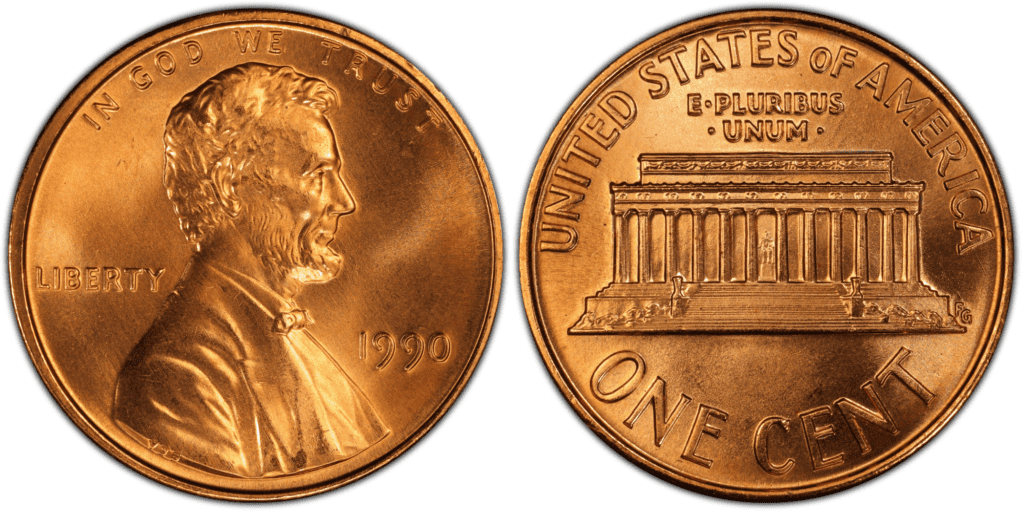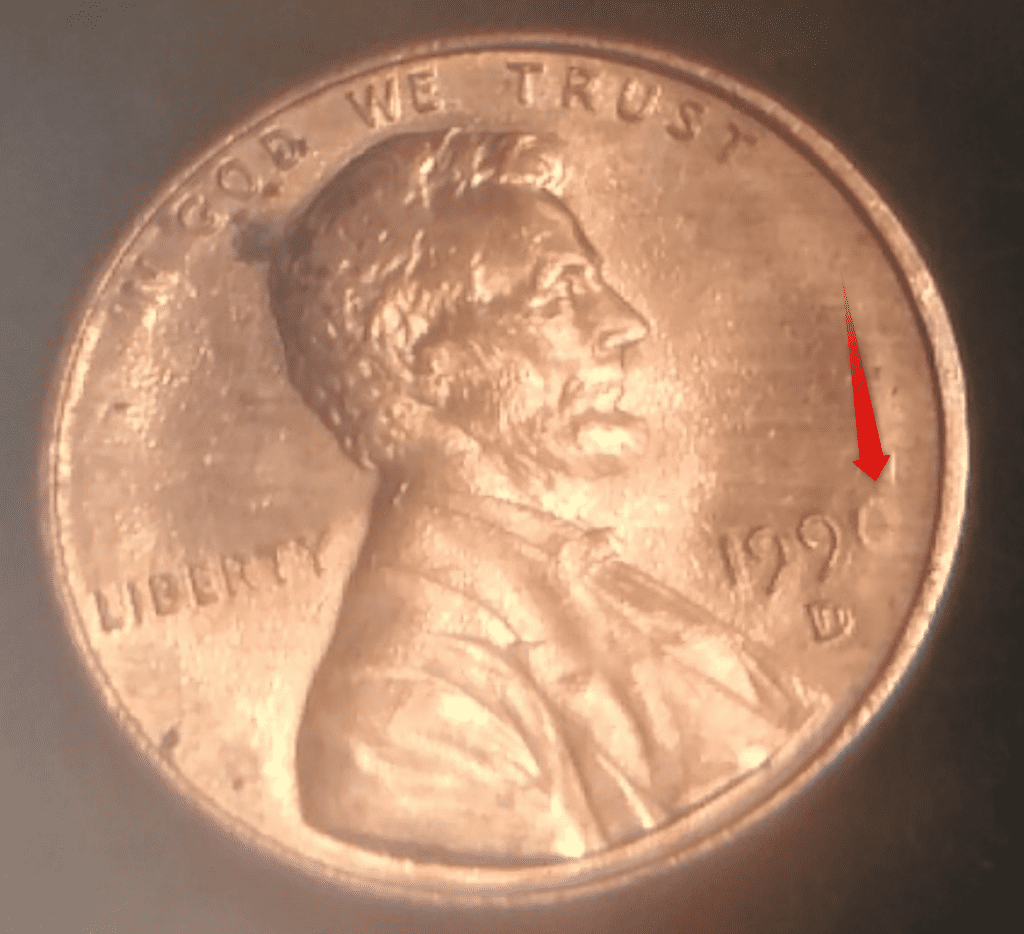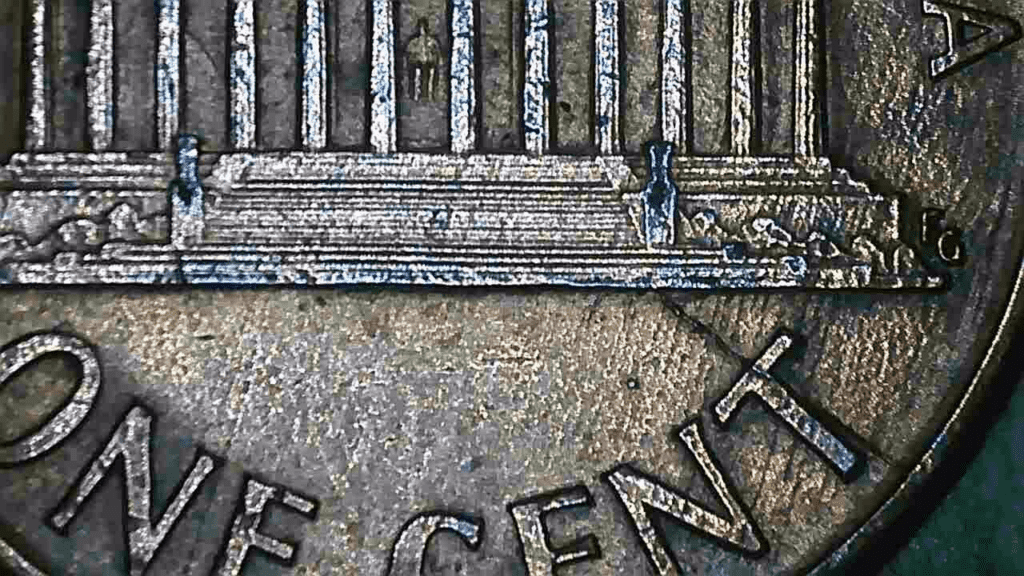What Is the 1990 Lincoln Penny Made Of?
The 1990 Lincoln penny is made of 97.5% zinc and 2.5% copper. In the past, from 1909 to 1942 and 1944 to 1982, the Lincoln penny was made of 95% copper and the rest was made of tin or zinc.
1943 is a unique year for the Lincoln Penny because it was the only year when it was made of zinc-plated steel.
The 1990 Lincoln penny has a mass of 2.5 grams. Previously, the coin was heavier at 4.11 grams as it was made of bronze from 1909 to 1982. The steel cents during World War II was 2.7 grams.
The diameter of the 1990 Lincoln cent is 19.05 mm. It has a plain edge as well.
The United States Mint started producing the Lincoln penny, better known as the Lincoln cent, in 1909. It has a face value of one cent and is the most produced type of coin in the United States.

As its name suggests, the obverse features the right profile of Abraham Lincoln, the 16th president of the United States. It was designed by Victor David Brenner.
Inscriptions on the obverse include the following:
- IN GOD WE TRUST (arching above the head of Lincoln)
- LIBERTY (on the back side of Lincoln)
- 1990 (in front of Lincoln)
- Mint mark (D, S, or P if present)
For the reverse, you’ll find the front view of the Lincoln Memorial. On top of the image is the U.S. motto, E Pluribus Unum, meaning, “Out of many, one.” On top of the coin is the arching inscription, “UNITED STATES oF AMERICA.”
Beneath the memorial are the words, “ONE CENT.” The reverse side was designed by Frank Gasparro.
The penny didn’t always bear the image of Abraham Lincoln. The first penny was produced in 1787. It has gone through different designs, from the flowing hair chain to the flying eagle cent.
In 1909, it was the centennial year of Lincoln’s birth. Thus, in that year, Congress agreed to add his image to the penny. Since then, the Lincoln penny was the first coin with a president’s face that has become widely used in the United States.
1990 Lincoln Penny Varieties
The 1990 Lincoln penny comes in different varieties. They are basically the same coins, but they differ based on their mint marks. Some varieties also come into existence because of the errors that happened before, during, or after the minting process.
Here are some of the most common 1990 Lincoln penny varieties you should know.
1990 D Lincoln Penny
Year of minting: 1990
Mint Mark: D
Place of minting: Denver
Quantity produced: 4,922,894,533
Face Value: $0.01 (one cent)
Price: $0.01 to $1.00 (or more)
Mass: 2.5 grams
Edge: Plain
Designer: Victor D. Brenner
Composition: 97.5% zinc and 2.5% copper
Diameter: 19.05 mm
Thickness: 1.52 mm

The 1990-D penny was made in the Denver Mint. You’ll find the D mint mark, like other mint marks, under the year 1990. Almost five billion pennies were produced in 1990. The 1990-D penny can be sold for around $0.01 to $1.00.
1990 P Lincoln Penny
Year of minting: 1990
Mint Mark: Absent
Place of minting: Philadelphia
Quantity produced: 6,851,765,000
Face Value: $0.01 (one cent)
Price: $0.01 to $1.00 (or more)
Mass: 2.5 grams
Edge: Plain
Designer: Victor D. Brenner
Composition: 97.5% zinc and 2.5% copper
Diameter: 19.05 mm
Thickness: 1.52 mm

The 1990-P Lincoln penny is typically sold for around $0.01 to $1.00. However, it can be higher than that if you have a unique and special penny. The “P” stands for the Philadelphia Mint. However, P Lincoln pennies don’t usually have mint marks.
1990 S Lincoln Penny
Year of minting: 1990
Mint Mark: S
Place of minting: San Francisco
Quantity produced: 3,299,559
Face Value: $0.01 (one cent)
Price: $0.01 to $2.00 (or more)
Mass: 2.5 grams
Edge: Plain
Designer: Victor D. Brenner
Composition: 97.5% zinc and 2.5% copper
Diameter: 19.05 mm
Thickness: 1.52 mm

The 1990-S Lincoln penny was made in the San Francisco Mint. Almost 3.3 million of these pennies were produced.
What’s special about the 1990-S Lincoln is that they are proof coins. This means that they are extra shinier and more detailed in nature. Because it takes more time and effort to produce proof coins, the San Francisco Mint only produced about 3 million 1990-S Lincoln pennies, which is far fewer than what the other Mint centers produced.
List Of 1990 Lincoln Penny Errors
As you can imagine, the Lincoln penny is the lowest coin denomination in the United States. They are produced in the billions. With a great amount of 1990 pennies, it is not surprising to know that there are coins that have received some errors during production.
Here are some examples:
1990 Lincoln Penny With Faded ‘0’

In this coin, the number zero in the year 1990 is almost non-existent. It is faded and barely noticeable. This type of error is more likely to be caused by the die struck through grease.
1990 No S Lincoln Penny

Perhaps, the most sought-after variety of the Lincoln penny is the 1990 No S Lincoln penny. According to some estimates, there are only less than 200 of these coins in existence today. It is extremely rare and thus, super valuable.
1990 Lincoln With Die Crack on Left Side Reverse From Building to Rim

As you can see in the image above, there’s a die crack found on the letter “T” of the cent. It runs from the rim to the first step of the Lincoln memorial. On eBay, this coin is priced at $6.50.
1990 Penny Blistering Error

This penny has some blister-like bumps on it. Instead of a smooth surface, the coin looks rough and old. You can buy or sell a penny like this for $5.
How Much Is the 1990 Lincoln Penny Worth Today?
If you’re talking about the face value, the 1990 Lincoln penny isn’t worth that much. It is worth only one cent. Not only that, but with billions of 1990 Lincoln penny, they are not all too rare, which easily decreased their value. Moreover, the melt value of a 1990 Lincoln penny is only $0.0075.
Nevertheless, you don’t have to worry because there are those 1990 Lincoln pennies that are worth a lot of money. The rarer your coins and the more impressive their condition, the higher is its value.
To give you an idea of how much these coins are worth, take a look at the comparison table below:
| Coin | Condition | Grade | Mintage | Value |
| 1990 D Lincoln Penny | Circulated/Mint | Not graded | 4,922,894,533 | $0.01+ |
| 1990 P Lincoln Penny | Circulated/Mint | Not graded | 6,851,765,000 | $0.01+ |
| 1990 S Lincoln Penny | Circulated/Proof | Not graded | 3,299,559 | $0.01 to $1+ |
| 1990 D Lincoln Penny | Uncirculated/Mint | MS-65 | 4,922,894,533 | $0.33 |
| 1990 P Lincoln Penny | Uncirculated/Mint | MS-65 | 6,851,765,000 | $0.33 |
| 1990 S Lincoln Penny | Uncirculated/Mint | PR-65 | 3,299,559 | $5.70 |
Perhaps, the most expensive type of the 1990 Lincoln penny would be the 1990 No S Lincoln penny. If you have this penny, you can sell it for at least $4,000.
How Does The Grading System Work?
The Sheldon Scale is used by numismatists to provide a numerical value to coins. The Sheldon Scale goes from poor (P-1) to perfect mint state (P-1) (MS-70). Coins were originally evaluated using words to reflect their condition (Good, Fair, Excellent, Etc.). Unfortunately, coin collectors and dealers had different ideas about what each of these terms represent.
Professional numismatists joined together in the 1970s and established CoinGrading standards. These numismatists now assign grades at key places on the seventy-point scale, using the most regularly utilized numeric points in conjunction with the original adjective grade. The following are the most common coin grades:
-
-
- (P-1) Poor – Indistinguishable and probably damaged; if used, must have a date and mintmark; otherwise, rather battered.
- (FR-2) Fair – Nearly smooth, but without the damage that a coin graded Poor often possesses. The coin must have enough detail to be identified.
- (G-4) Fair – Inscriptions have merged into the rims in some areas, and important elements have been mostly erased.
- (VG-8) Very Good- A little weathered, but all of the primary design elements are visible, albeit faintly. There is little if any, central detail left.
- (F-12) Good – The item is very worn, yet the wear is even, and the overall design details stand out clearly. Rims are almost completely isolated from the field.
- (VF-20) Very Fine – Moderately weathered, with some finer features still visible. The motto or all letters of LIBERTY are readable. Both sides of the coin have entire rims that are separated from the field.
- (EF-40) Extremely Fine – Gently used; all gadgets are visible, and the most important ones are bold. The finer details are bold and clear, however, light wear may be seen.
- (AU-50) Uncirculated – Slight evidence of wear on the coin’s design’s high points; may have contact marks; eye appeal should be adequate.
- (AU-58) Uncirculated Choice – Slight traces of wear, no severe contact marks, almost full mint shine, and great eye appeal.
- (MS-60) Mint State Basal – Strictly uncirculated; no indication of wear on the coin’s highest points, but an unsightly coin with reduced luster, visible contact marks, hairlines, and other flaws.
- (MS-63) Mint State Acceptable – Uncirculated, but with contact scratches and nicks, little reduced shine, but otherwise appealing appearance. The strike is weak to average.
- (MS-65) Mint State Choice – Uncirculated with great mint shine, very little contact blemishes, and exceptional eye appeal. The strike is unusually severe.
- (MS-68) Mint State Premium Quality – Uncirculated with superb luster, no obvious contact marks to the naked eye, and exceptional eye appeal. The strike is quick and appealing.
- (MS-69) Almost Perfect Mint State – Uncirculated with perfect brilliance, a sharp and appealing strike, and extremely good eye appeal. A near-perfect coin with minor imperfections in the planchet, strike, and contact markings (seen only under 8x magnification).
- (MS-70) Mint State Perfect – Under 8x magnification, there are no tiny imperfections discernible; the strike is crisp, and the coin is perfectly centered on a beautiful planchet. Rarely seen on a coin, this coin is bright and whole, with original luster and exceptional eye appeal.
-
Are There Any Rare 1990 Lincoln Penny?
Yes, there are rare 1990 Lincoln pennies that you should know. Usually, the rare ones are rare because of their high-quality condition.
For example, pennies with grades MS67 and above can be considered rare because only a few pennies receive this grade.
Perhaps, the rarest variety of 1990 Lincoln Penny is the “No S” type. According to some estimates, there are only at least 200 of these coins in existence today.
So, what happened and how did the No-S 1990 Lincoln penny come about? It was in 1986 that the U.S. Mint decided to change the way they punch mint marks. This change led to the accidental creation of the No-S variety.
The original plan was to use the mint state die, but instead, the proof die was used. Since the mint mark was removed, workers didn’t notice that they were using the proof die.
Although the S was missing on the coin, it is easy to determine that it came from the San Francisco Mint because it is only this Mint that creates proof coins.
The error was immediately discovered. Thus, only about 200 of these coins were produced. The rarity of the No-S 1990 Lincoln penny makes it more valuable than any other variety. You can sell the No-S penny for thousands of dollars.
Where To Buy Or Sell 1990 Lincoln Penny?
There are a lot of places where you can buy and sell 1990 Lincoln pennies. First off would be the Internet. Living in a digital age, you can go to online marketplaces such as Amazon, eBay, and Etsy. You can also do an internet search and find websites that specialize in buying or selling Lincoln pennies. Examples would include USA Coin Book, Coin Tracker, and Coin Appraiser.
You can also visit physical stores such as coin shops, antique shops, and collectors’ hubs. Check out auction houses as well. You might be able to find rare and unique 1990 Lincoln pennies.
FAQs
How do I know if my 1990 penny is worth money?
A 1990 penny in uncirculated condition is worth more than other types of 1990 pennies. Look at your penny. If it is still pristine, flawless, and scratch-free, then it can be worth more than just one cent.
Moreover, rare pennies that come with some sort of error could also be more valuable. Errors can sometimes make a coin unique, which occasionally increases its value.
After initially inspecting your coin and you have a feeling that it can be worth more, you can go ahead and talk to a coin appraiser. You can let them check your 1990 Lincoln penny. Be sure to work with a reputable and trusted company, so that you get an accurate appraisal.
Is there a rare 1990 penny?
The rarest 1990 penny that is worth a lot of money would be the 1990 No-S Lincoln penny.
How many pennies were minted in 1990?
There were 11,777,959,092 Lincoln pennies produced in 1990. The Denver Mint produced 4,922,894,533 pennies. The Philadelphia Mint produced 6,851,765,000 pennies. The San Francisco Mint produced 3,299,559 pennies.
